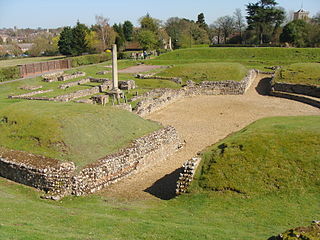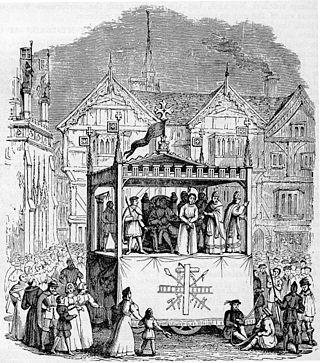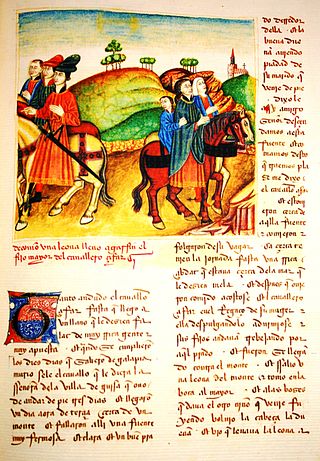
Drama was introduced to Britain from Europe by the Romans, and auditoriums were constructed across the country for this purpose.

The Chester Mystery Plays is a cycle of mystery plays originating in the city of Chester, England and dating back to at least the early part of the 15th century.
The N-Town Plays are a cycle of 42 medieval Mystery plays from between 1450 and 1500.

Christian drama or Christian tragedy is based on Christian religious themes.

Medieval theatre encompasses theatrical in the period between the fall of the Western Roman Empire in the 5th century and the beginning of the Renaissance in approximately the 15th century. The category of "medieval theatre" is vast, covering dramatic performance in Europe over a thousand-year period. A broad spectrum of genres needs to be considered, including mystery plays, morality plays, farces and masques. The themes were almost always religious. The most famous examples are the English cycle dramas, the York Mystery Plays, the Chester Mystery Plays, the Wakefield Mystery Plays, and the N-Town Plays, as well as the morality play known as Everyman. One of the first surviving secular plays in English is The Interlude of the Student and the Girl.
The Wakefield or Towneley Mystery Plays are a series of thirty-two mystery plays based on the Bible most likely performed around the Feast of Corpus Christi probably in the town of Wakefield, England during the Late Middle Ages until 1576. It is one of only four surviving English mystery play cycles. Some scholars argue that the Wakefield cycle is not a cycle at all, but a mid-sixteenth-century compilation, formed by a scribe bringing together three separate groups of plays.

The York Mystery Plays, more properly the York Corpus Christi Plays, are a Middle English cycle of 48 mystery plays or pageants covering sacred history from the creation to the Last Judgment. They were traditionally presented on the feast day of Corpus Christi and were performed in the city of York, from the mid-fourteenth century until their suppression in 1569. The plays are one of four virtually complete surviving English mystery play cycles, along with the Chester Mystery Plays, the Towneley/Wakefield plays and the N-Town plays. Two long, composite, and late mystery pageants have survived from the Coventry cycle and there are records and fragments from other similar productions that took place elsewhere. A manuscript of the plays, probably dating from between 1463 and 1477, is still intact and stored at the British Library.
PLS, or Poculi Ludique Societas, the Medieval & Renaissance Players of Toronto, sponsors productions of early plays, from the beginnings of medieval drama to as late as the middle of the seventeenth century.
The Records of Early English Drama (REED) is a performance history research project, based at the University of Toronto, Ontario, Canada. It was founded in 1976 by a group of international scholars interested in understanding “the native tradition of English playmaking that apparently flourished in late medieval provincial towns” and formed the context for the development of the English Renaissance theatre, including the work of Shakespeare and his contemporaries. REED's primary focus is to locate, transcribe, edit, and publish historical documents from England, Wales, and Scotland containing evidence of drama, secular music, and other communal entertainment and mimetic ceremony from the late Middle Ages until 1642, when the Puritans closed the London public theatres.
A mansion stage is a stage for theatrical performances. They originated in churches where they were small wooden platforms with supports and a roof. Mansions were stage structures used in medieval theatre to represent specific locations, such as Heaven or Hell. The actors would move between these mansions as the play demanded. The acting area of the stage was called the platea, and mansions were placed around the platea. As the actors moved between the mansions, the platea would take on the scenic identity of each mansion. In England, pageant wagons were used for the cycle dramas to hold the mansion, the plateau, and a dressing area. These were used to move the scene from one audience to the next, unlike in the church where the mansions were stationary and both the performer and the congregation would move from mansion to mansion.

Theatre of United Kingdom plays an important part in British culture, and the countries that constitute the UK have had a vibrant tradition of theatre since the Renaissance with roots going back to the Roman occupation.

Arthur Clare Cawley was Professor of English Language and Medieval English Literature at the University of Leeds.
The Brome play of Abraham and Isaac is a fifteenth-century play of unknown authorship, written in an East Anglian dialect of Middle English, which dramatises the story of the Akedah, the binding of Isaac.

The Digby Conversion of Saint Paul is a Middle English miracle play of the late fifteenth century. Written in rhyme royal, it is about the conversion of Paul the Apostle. It is part of a collection of mystery plays that was bequeathed to the Bodleian Library by Sir Kenelm Digby in 1634.
Le Jeu d'Adam is a twelfth-century liturgical drama written in the Anglo Norman dialect of Medieval French. While choral texts and stage directions are in Latin, the spoken text of the play is in the vernacular, which makes the Adam the oldest extant play written in any old French dialect. It is a dramatic representation of the temptation and fall of Adam and Eve, the story of Cain and Abel, and a series of prophets including Isaiah and Daniel. The latter part of the play is largely taken from the Latin Sermo Contra Judaeos, Paganos et Arianos, attributed to pseudo-Augustine. It is part of the medieval tradition of mystery plays, which developed from dramatic elements in the celebration of Mass, and includes choral music.

The Second Shepherds' Play is a famous medieval mystery play which is contained in the manuscript HM1, the unique manuscript of the Wakefield Cycle. These plays are also referred to as the Towneley Plays, on account of the manuscript residing at Towneley Hall. The plays within the manuscript roughly follow the chronology of the Bible and so were believed to be a cycle, which is now considered not to be the case. This play gained its name because in the manuscript it immediately follows another nativity play involving the shepherds. In fact, it has been hypothesized that the second play is a revision of the first. It appears that the two shepherd plays were not intended to be performed together since many of the themes and ideas of the first play carry over to the second one. In both plays it becomes clear that Christ is coming to Earth to redeem the world from its sins. Although the underlying tone of The Second Shepherd's Play is serious, many of the antics that occur among the shepherds are extremely farcical in nature.
A pageant wagon is a movable stage or wagon used to accommodate the mystery and miracle play cycles of the 10th through the 16th century. These religious plays were developed from biblical texts; at the height of their popularity, they were allowed to stay within the churches, and special stages were erected for them.

Medieval Spanish literature consists of the corpus of literary works written in Old Spanish between the beginning of the 13th and the end of the 15th century. Traditionally, the first and last works of this period are taken to be respectively the Cantar de mio Cid, an epic poem whose manuscript dates from 1207, and La Celestina (1499), a work commonly described as transitional between the Middle Ages and the Renaissance.
The pageant of Magnus Herodes is the sixteenth of the pageants of the Towneley Cycle of medieval mystery plays. It occupies folios 55-60 of the unique manuscript of the cycle, Huntington MS HM 1. It is composed in the distinctive stanza-style rhyming associated by scholars with a putative poet known as the 'Wakefield Master'. In the assessment of A. C. Cawley, 'the Wakefield playwright's skill in characterisation is nowhere better shown than in this pageant'. Like other tyrant characters in medieval drama, the protagonist of Herod the Great fictionalises the audience as his own subjects, and this pageant 'presents one of the most extended displays of this figure's interactive antics'.
Passion Plays in the United Kingdom have had a long and complex history involving faith and devotion, civic pageantry, antisemitism, religious and political censorship, large-scale revival and historical re-enactments. The origin and history of Passion Play in the UK differs substantially from Passion Plays in Europe, South and North America, Australia and other parts of the world.











